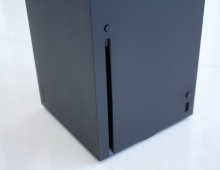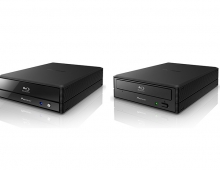
Researchers Burn BD-Rs at 12x
Researchers announced at ISOM 2006 important new developments involving high-speed recording on Blu-Ray media, presenting recordings on Blu-Ray discs at speeds as high as the 12x.
Philips researchers (R. G. J. A. Hesen, J. H. G. Jaegers, A. P. G. E. Janssen, J.Rijpers, P. R. V. Sonneville, J. J. H. B. Schleipen (Philips Research, Netherlands)) discussed their 10x and 12x recording experiments on Cu:Si-based BD-R discs.
Pushing the recording speeds further is not an easy task and requires developments in both hardware and materials. Disc physical parameters are also a limiting factor for the maximum attainable writing speed, including a high noise level during recording as well as vibration. But the most important factor is the maximum allowed spinning speed of an optical disc. For 12cm discs (CD/DVD), spinning an optical disc at 10,800rpm has been proven as the realistic upper bound for half-height drives. A 12cm BD disc rotates between 1955 and 821rpm (inner to outer diameter) at 1X speed, so simple calculations result to the fact that the 12X (CAV) is expected to be the upper limit (ceiling) for BD devices on a PC. This is a simple theoretical approach and of course, reaching the 12x CAV writing speed also depend on the developments on the chemicals used for the disc and the performance/accuracy of the moving parts (hardware) used in a BD recorder.
Philips showcased that the 7x (4-7x CAV) as well as at the 10x and 12x recording speeds on BD-R media has already been achieved. The BD-R media used for the experiments was not featuring a phase-change or a dye layer, but instead a Cu/Si bilayer was applied. TDK was the first to propose the use of Cu and Si as a recording medium in a write-once Blu-Ray disc. Under the impact of a laser power the two layers mix, thus creating a recording mark having a reflectivity that differs markedly from its non-irradiated environment. But the actual challenge here is to define the thickness of each layer (element) that will give the best results (reflectivity e.t.c) for an optimized writing strategy.
Philips scientists claim that their experiments with the their Cu/Si media were successful and that they achieved adequate a recording quality (jitter below 7%).
So as long as both blank discs and component designs can keep up, a full BD-R (SL) disc may be eventually written in approximately 11 minutes in case of rewritables and multilayered discs. In practice, the upper limit might prove to be as low as 7x, due to their complicated structure and their high spinning speed at such high speeds. But Philips said that it expects that the implications of high speed recording on servo bandwidths and system margins will be solved soon.
Pushing the recording speeds further is not an easy task and requires developments in both hardware and materials. Disc physical parameters are also a limiting factor for the maximum attainable writing speed, including a high noise level during recording as well as vibration. But the most important factor is the maximum allowed spinning speed of an optical disc. For 12cm discs (CD/DVD), spinning an optical disc at 10,800rpm has been proven as the realistic upper bound for half-height drives. A 12cm BD disc rotates between 1955 and 821rpm (inner to outer diameter) at 1X speed, so simple calculations result to the fact that the 12X (CAV) is expected to be the upper limit (ceiling) for BD devices on a PC. This is a simple theoretical approach and of course, reaching the 12x CAV writing speed also depend on the developments on the chemicals used for the disc and the performance/accuracy of the moving parts (hardware) used in a BD recorder.
Philips showcased that the 7x (4-7x CAV) as well as at the 10x and 12x recording speeds on BD-R media has already been achieved. The BD-R media used for the experiments was not featuring a phase-change or a dye layer, but instead a Cu/Si bilayer was applied. TDK was the first to propose the use of Cu and Si as a recording medium in a write-once Blu-Ray disc. Under the impact of a laser power the two layers mix, thus creating a recording mark having a reflectivity that differs markedly from its non-irradiated environment. But the actual challenge here is to define the thickness of each layer (element) that will give the best results (reflectivity e.t.c) for an optimized writing strategy.
Philips scientists claim that their experiments with the their Cu/Si media were successful and that they achieved adequate a recording quality (jitter below 7%).
So as long as both blank discs and component designs can keep up, a full BD-R (SL) disc may be eventually written in approximately 11 minutes in case of rewritables and multilayered discs. In practice, the upper limit might prove to be as low as 7x, due to their complicated structure and their high spinning speed at such high speeds. But Philips said that it expects that the implications of high speed recording on servo bandwidths and system margins will be solved soon.



















